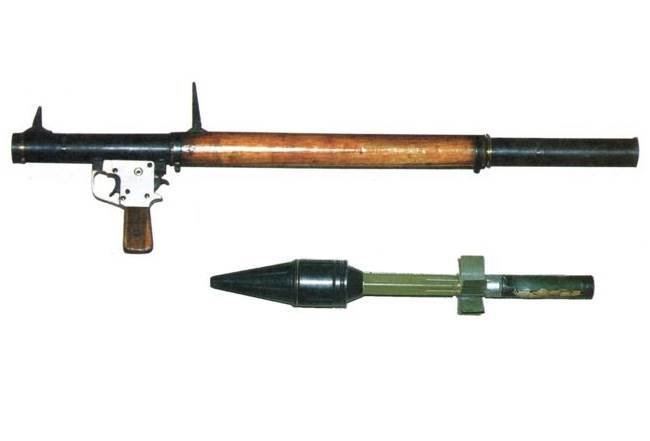RPG-2
| Factions | Weapon | Icon | Classes | Ammo | Explosion | |
|---|---|---|---|---|---|---|
| Damage | Radius | |||||
 VC |
 RPG-2 |
 |
1 / 2 | 125 | 200 | |
| Designation | Weapon Type | Fire Modes | Fire Rate | Bullet Spread ° | Range Modifier | Muzzle Velocity | Projectile weight | Reload Speed | |
|---|---|---|---|---|---|---|---|---|---|
| RPG-2 | Grenade Launcher | Single Shot | 12 RPM | 3° & 1° ADS | Unaffected | 60m/s | 230 g (.5 lbs) | 7 kg (15.43 lbs) | 3.5 Seconds |
| Full name | Ammo Type | Place of Origin | Date | Manufacturer | Effective firing range | Total Length | Weapon Script Name |
|---|---|---|---|---|---|---|---|
| РПГ-2, Ручной противотанковый гранатомёт, Ruchnoy Protivotankovy Granatomyot | rpg round | Soviet Union | 1954 | State Factories | 100–150 m | 47.2 in (1,200 mmm) | weapon_rpg2 |
The RPG-2 is a man-portable, shoulder-fired anti-tank weapon that was designed in the Soviet Union. It was the first successful anti-tank weapon of its type, being a successor to the earlier and unsuccessful rocket-propelled grenade RPG-1.
The RPG-2 offered better range and armor penetration, making it useful against late and post-World War II tanks, in contrast to the RPG-1 that had only marginal utility. The basic design and layout was further upgraded to produce the ubiquitous RPG-7.
HISTORY
Studying German and US anti-tank rocket designs, in 1944 the Soviets began development of the RPG-1 with the goal of combining the best features of the German Panzerfaust single shot recoilless weapon with the US Bazooka rocket launcher. Propelled by a 30 mm cartridge, the 70 mm (2.8 in) high-explosive anti-tank (HEAT) shaped charge round could penetrate about 150 mm (5.9 in) of homogeneous armor.
Early testing revealed several minor problems, but, by the time these were being solved, 150 mm of penetration was no longer considered effective against modern tanks, even late-war designs like the Panther. The warhead was already straining the abilities of the cartridge and its range was already considered too low. Modifications to improve this began, but in 1947 the RPG-2 program began as a parallel project. Development of the RPG-2 was carried out by the GSKB-30 design bureau, originally part of the Commissariat for Munitions, but in the post-war period handed to the Ministry of Agriculture to help design farm equipment.
The main difference in performance between the two were due to size. The RPG-2 used a custom designed 40 mm (1.6 in) cartridge to provide much greater power, and the warhead enlarged to 80 mm (3.1 in). This improved penetration to 180 mm (7.1 in), which allowed it to penetrate the frontal armor of all but the very heaviest tanks, and the side and rear armor of any tank. The larger cartridge gave the PG-2 warhead slightly better practical range as well, about 150 m (490 ft) against stationary targets.
The design of the PG-2 differed considerably from that of the PG-1 of the RPG-1. The rear section of the PG-1 consisted of a central tube holding the propelling charge, and a second tube around this carrying the fins. When the round was inserted into the launcher, the second tube was outside the launcher tube, requiring the front of the launcher to be free of any fittings. The PG-2 replaced the fins with small metal leaves attached to the inner tube, and eliminated the outer tube found on the PG-1. This allowed the entire propellant section to be inserted into the launcher, which in turn allowed the sights and trigger assembly to be mounted right at the front of the launcher. This slightly reduced the length compared to the RPG-1, made the entire assembly more robust, and allowed the use of conventional fore-and-aft sights.
The new design was such an improvement on the earlier design that development of the RPG-1 ended in 1948. The first production versions of the RPG-2 entered service with the Soviet Army's infantry squads in 1954. Although the RPG-2 could be operated by one man, standard military practice called for a two-man crew: a grenadier carrying a Stechkin APS, the launcher and a purpose-built backpack containing three grenades and an assistant armed with a rifle and carrying another three-grenade backpack.
Widely distributed to allies of the Soviet Union, it was also produced under license by China, North Vietnam and North Korea. Used against the U.S. military in the Vietnam War, its Vietnamese variants were called the B40 (Ba Do Ka - "Bazooka 40mm") and B50. B50 was B40 using Chinese Type 50 HEAT warhead (Chinese version of PG-2).
SOURCE




